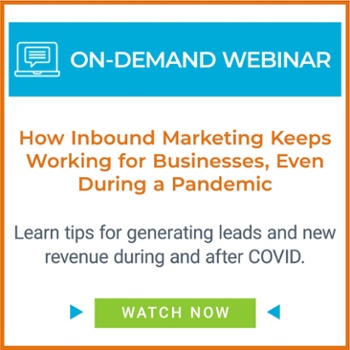Inbound Marketing Commandment #5: You Must Have Someone Responsible
As part of the LeadG2 series on "The 10 Commandments of Inbound Marketing" we will look at each of these ten commandments and why these principles...


Inbound marketing is what's in, and there's a very good reason for that — it works.
Companies selling business-to-business (B2B) and living in the 21st century need to find new, innovative ways to market their business to customers, especially the tech-savvy consumers of today. Inbound marketing is a proven strategy for creating meaningful relationships that will turn interested prospects into loyal customers.
In this post, we'll show you some B2B inbound marketing examples that left impressions on consumers. But first, let's talk a little bit about inbound marketing.

Inbound marketing is a business methodology that attracts the attention of prospects and new customers via strategic content creation and experiences that are tailored to their unique needs and buying journey. Content marketing, social media, and search engine optimization (SEO) are all avenues of inbound marketing that can be used to improve lead generation, drive more traffic, and most importantly, increase sales.
Inbound marketing is about forming connections, answering questions, and solving problems. Remember, you're still selling to humans. You're never actually selling to a business, you're selling to a business decision-maker — and they're all people.
Inbound marketing campaigns will generally fall into one of two categories: B2B or business-to-consumer (B2C).
B2B inbound marketing is any content or marketing strategy that is directed toward a business or organization, as opposed to marketing to general consumers (B2C). B2B inbound marketing is the strategy you'll want to use if your business sells products or services to other businesses or organizations.
Before we take a look at specific successful B2B inbound marketing examples, there are three basic B2B marketing strategies you can use as a starting point. Sharing actionable and relevant information to connect with potential customers will set your business up for success, and this can be done through blogs, video content and e-books.
Regularly publishing new articles on your blog allows you to tap into your creative side. If done consistently, it's also an effective way to establish your business as an expert in your industry and provide the value that attracts potential customers.
When beginning or revamping your blogging strategy, there are a few principles to keep in mind:
Be human. This translates across all industries; write your content in a way that's relatable to potential customers. Make sure your content frames your business as educational but approachable.
Use visuals. The average consumer prefers not to read blocks of text if they don't have to, so improve the readability of your blogs with pictures, videos, graphs, tables, GIFs, or slide decks. Using visual content every 75 to 100 words in a blog can also increase its social media engagement.
Use keywords. Your blogs need to be searchable by your potential customers. Use relevant keywords in each blog post's title, body text, and meta description to ensure your posts are ranking highly and reaching your audience's eyes.
Proofread. This goes for all your content, not just your blogs. Spelling and grammatical errors can very quickly undermine the effectiveness of your message and your position as an expert in your field. Consider using proofreading and writing analysis software, or hiring a professional copywriter.
Videos are an engaging form of content, with the average consumer often opting to watch a video rather than read an article. Producing video content can put your message in front of potential customers and put your business top-of-mind.
Using videos gives you the chance to share concepts and ideas about your industry simply and visually. It also allows you to establish your brand and entertain your audience if that's your current goal.
The key is to get creative. You can share highlights from an industry event, film an expert in your company sharing some quick business tips or host a game show in your office.
Your videos don't have to be movie-quality either. Your audience is looking for consistency and authenticity from your business, so start with what you're able to do. If all you're able to do is film a one-minute video on your phone every other day, then do just that.
According to research from HubSpot, marketers who use video content achieve 49% faster revenue than marketers who don't. Video content is worth the investment, as long as it's done consistently and with the audience in mind.
A bit different than blogs and videos, gated content like eBooks, mean that potential customers now give you contact information, such as an email address, in exchange for the actionable, expert information you're providing.
Here are a few things to keep in mind when creating gated content like an eBook:
Create a strong landing page. Landing pages are where a potential customer should be directed after clicking your call to action (CTA) button that invites them to download the e-book. The landing page should have a catchy description of the e-book, as well as a form for the reader to give their contact information, which converts them to an active lead.
Be informative. Remember, your potential customers have given contact information for the download. The insights and solutions you provide in an e-book should be more valuable than what your blogs and videos contain.
Deliver Value. Be intentional about creating valuable content that answers the questions of your readers. Give them more than you would on a typical blog post.
Format correctly. Make sure prospects who supply their contact information are able to easily view and/or download the e-book as often as they like. It's also beneficial to make the e-book visually appealing with contextual images throughout.
Follow up. You now have the contact's information. Converting that lead is up to your sales team.
B2B inbound marketing has been used by businesses in several industries to build meaningful customer relationships and boost sales. Below are a few examples of companies that have successfully used B2B marketing strategies:
Zimmer Radio & Marketing Group, a family-owned company with nine radio stations and various digital marketing services, started seeing leads come in immediately once they implemented an inbound marketing strategy through LeadG2 services. Leads steadily increased and became more qualified, but even more, they closed over $500,000 in the first 18-months! Click here to learn more.
HootSuite, which offers a social media management dashboard, leveraged the power of case studies into a powerful video content series that showcased customers' success stories. This marketing strategy was especially effective when marketing to software as a service (SaaS) businesses, where testimonials are often needed to capture the customization of such products.
Check out the series on their YouTube channel to see an impressive example of each part of the video process: interviewing, production, and editing.
Litmus is an email testing and analytics platform that used visually appealing email campaigns to inspire recipients and attract customers. Litmus's emails didn't use blocks of static text, opting instead for bold colors and images that more closely resembled a website than an email. This strategy paid off, landing more emails in subscribers' inboxes and avoiding spam folders more effectively.
Autodesk, a software builder, launched its own blog in 2013, called Line//Shape//Space. Since its launch, Line//Shape//Space has driven a lot of traffic to Autodesk's website, due largely to the blog's goal to inspire all businesses that do design work of any kind. Using practical business advice, innovative design examples and riveting imagery, Line//Shape//Space shows how powerful blogging is for building customer relationships. Stories like the “Future of Construction: Your Next Building Won’t Be Built—It Will Be Manufactured” create real added value and has been shared thousands of times.
This example technically isn't only B2B, but it's still a helpful demonstration of how to use social media to drive engagement. Building brand awareness is an important step to establishing your presence in your industry, and outdoor apparel brand REI did just that with its #OptOut social media campaign on Black Friday in 2015. Rather than try to get customers into its stores, REI encouraged consumers to spend the day in nature instead of in the mall. It was certainly unusual, but it generated a great amount of social media attention.
Creating interesting and informative content for over 300 million professionals isn't easy. However, LinkedIn has make it work in the form of helpful content centered around its own network. This includes guides for LinkedIn campaigns, infographics for profile optimization, eBooks, SlideShare presentations, webinars and tips and tricks — all geared towards a professional audience.
The example of the Sophisticated Marketer’s Guide to LinkedIn campaign, which appeared in all forms including print, is just one form of inbound marketing success. Within the first 30 days, the guide was downloaded 10,000 times, and LinkedIn was able to win more than a third of readers as customers. In addition, around 3,000 new registrations were recorded after the seminar.
PRemployer, a human resource outsourcing firm, saw increased sales including 15 new client contracts, a new revenue source, and stronger brand awareness through their partnership with LeadG2 and inbound marketing implementation. Here are the details:
Mattermark, which assists with lead building through customer intelligence, aims to educate its audience through the "Raise the Bar" newsletter, which consists of a "daily digest of timely, must-read posts on sales, marketing and growth engineering.” Armed with well-curated content, the "Raise the Bar" newsletter informed Mattermark's audience and built loyalty for the brand.
Wistia, a video hosting platform, utilizes humanizing their brand and connecting with their audience by uploading photos of employees – and their dogs – on Instagram. This not only fits with the visual focus of the company, but is also a proven successful inbound marketing tactic.
Regardless of your industry, visual incentives and making human connections is always key. You don't have to have your own YouTube channel, but think about what potential readers like to see, and where they view most of this visual content. Pictures in blog posts already increase readability immensely, and for some B2B companies, even creating their own Facebook page can open up completely new possibilities.
If you're like the best companies out there, you've decided that your business would benefit from a strong inbound marketing initiative. Sticking your highly-paid salespeople behind their desks to make cold calls is way too expensive. And you know you could get a much better ROI with a strong inbound marketing initiative that generates quality leads.
While making the decision to start an inbound marketing program was probably easy, now, you need to decide exactly how you are going to do that. And that can be a bit more challenging. Do you do it yourself or hire an expert? If lead generation and thought leadership are important, then we suggest hiring an expert to help — either to coach you to do it yourself, or to do it for you.

As part of the LeadG2 series on "The 10 Commandments of Inbound Marketing" we will look at each of these ten commandments and why these principles...

Optimizing your inbound marketing performance starts with measuring the key metrics that show you if your strategy is effective or if it’s time to...

Tomorrow morning each of us at LeadG2 will be hopping on airplanes out of our respective cities to head to Boston for INBOUND 2015—the yearly...